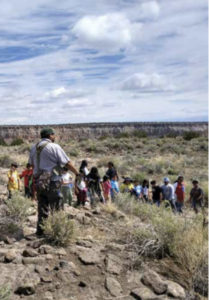A Year of Revealing Research: Advancing Archaeological Knowledge

Research and education at the Office of Archaeological Studies benefited from the generosity of private donors during fiscal year 2021-2022 (July 1, 2021 to June 30, 2022), generating a total of $189,233 from individuals, endowment payouts and grants.
A portion of these funds enabled OAS staff to pursue research and share knowledge beyond the salvage archaeology projects that help support this nonprofit enterprise division of the Museum of New Mexico system.
The Center for New Mexico Archaeology, the hub for OAS’s five specialized research laboratories, again had a robust research year, thanks to total endowment payouts of $56,594 from the Dr. Don E. Pierce Endowment Fund, Albert Simms Endowment Fund and the Friends of Archaeology Endowment Fund, as well as private research-designated gifts.
Thanks to this wide-ranging support, the OAS radiocarbon sampling laboratory, under the direction of Dr. Marvin Rowe, engaged staff and volunteers in work on 11 projects for various international clients in FY22. This resulted in more than 70 dates of OAS plasma oxidation samples, including the first ever dates for rock art from the Sultanate of Oman. Another exciting project used insect fecal pellets to date Coptic textiles.
A third study, the radiocarbon dating of juniper ceiling wood from Room 219 at Aztec Ruins National Monument in north-western New Mexico, also illuminated new discoveries. While tree-ring dating of pine and fir ceiling materials at the ruins documented beam harvest and construction dates between 1111 and 1113 CE (AD), growth patterns in the juniper ceiling were too erratic to establish climate correlations. Repeated radiocarbon sampling of the outer rings revealed that the juniper died 230 to 430 years earlier than the cutting of the other woods. Juniper trees can survive as standing dead wood long after other species have decayed, and the Room 219 wood fits that model.
“The dating discrepancy is a warning of the pitfalls of relying on only one approach to dating archaeological structures,” says Office of Archaeological Studies Director Eric Blinman. “Private support through the Museum of New Mexico Foundation allows our specialized research laboratories to go beyond simple answers to questions.”
Other vital information about New Mexico’s archaeological past was uncovered in FY22 in the OAS osteology lab via analysis at Pindi Pueblo, where site excavations in the 1930s recovered more than 80 burials of village residents. OAS Archaeologist Ann Stodder assembled a team of bioarchaeologists to describe these individuals and begin to create life histories.
Initial observations are that the Pindi residents were taller and generally healthier than residents of the later Classic period sites. Although there are traces of tuberculosis at Pindi, the incidences are fewer than at the later and more crowded villages. Data analysis is ongoing, and the team may be able to suggest whether the same or different genetic populations account for the discrete occupations.
Reaching Tribal Communities
The awarding-winning educational programs of OAS were also bolstered by private giving in FY22, including $14,527 in support from the OAS Education Fund via the Foundation. Additionally, a Futures for Children Legacy Fund grant allowed OAS staff to work with tribal schools and organizations in the design and delivery of education programs.
The highlight of the year, a collaboration with San Ildefonso Pueblo Day School, resulted in a multi-day program focusing on knowledge of the environment around the Pueblo. Tribal elders engaged students in the spiritual and historical importance of traditional places. On other days, students learned concepts and practices of mapmaking.
Students also took field trips, including one to Bandelier National Monument for an introduction to plants, animals, geology and geomorphology. They spent another day at the Center for New Mexico Archaeology, where they were intro- duced to the diversity and sophistication of traditional tech- nologies, including ancient hunting techniques, yucca textiles and ethnobotany. They also learned about modern technologies of dating and geographic information systems.
To support the Office of Archaeological Studies, contact Lauren Paige at 505.982.2282 or Lauren@museumfoundation.org.
This article and image are from the Museum of New Mexico Foundation’s Member News Winter 2022.
Image of San Ildefonso Day School students participated in a field trip to Tsankawi as part of an Office of Archaeological Studies educational collaboration in FY22. Photo by Isaiah Coan, courtesy OAS.


Connect